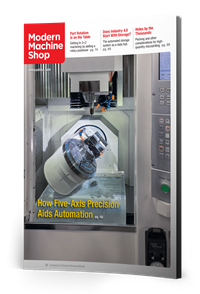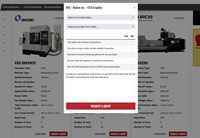What to Know About Adjustable Bore Gages
These comparative instruments must be set to the required nominal size, and there are a number of ways to do this.
Share


Hwacheon Machinery America, Inc.
Featured Content
View More







Adjustable bore gages are comparative-type instruments. This means that, whether it be a dial or digital indicator, the readout will show the amount and direction of variation in the test bore from nominal size. That being the case, the gage needs to be set to the required nominal size to which the actual bore is to be compared.
The gaging components of an adjustable bore gage are mainly in its head. These include a sensitive contact through which the measurement is transferred mechanically to the readout device, a pair of centralizing contacts that align the gage radially to the bore and a reference contact that is used to set nominal size. Setting the bore gage consists of adjusting this reference contact to produce a zero reading on the indicator when the gage is measuring the nominal size.
There are a number of ways that the adjustable bore gage can be set to the nominal size. Some are good for a quick setup, some are more precise but can be expensive, and some provide a good balance of reliability and versatility.
Using an outside micrometer may be the quickest and most readily available method, but there are issues with the accuracy of this setup. Micrometers have inherent errors that can be passed along to the gage. Another concern related to using a micrometer is accurately locating and aligning the spherical measuring points of the gage on its contacts. While readily available and inexpensive, this setup method probably offers accuracy of no better than 0.002 inch. This accuracy must be compared to the part tolerance to see what portion is consumed by inherent error.
Probably the best method for setting the adjustable bore gage is using a master ring. This duplicates the actual measurement, and master rings can be made very close to the part size. Most bore gages have a flat surface on the head that is parallel to the reference and sensitive contact. Using this method, the ring is laid on a granite surface plate; the bore gage is set in the ring, which will support it; and the sensitive contact is adjusted until the indicator reads zero. It is even possible to use a ring gage that is not exactly the nominal size, as the offset can be incorporated into the set of the dial indicator. A ring gage is the preferred method for setting repetitive sizes or when an adjustable bore gage is going to be dedicated to a particular size. The downside of this method is the potential cost: 1) rings can be expensive, especially if one is required for each of many sizes on the shop floor; 2) users tend to over-specify master rings to XX tolerance accuracies, which may not be required for the tolerance of the part; and 3) for each master ring needed, there will be storage and annual certification costs. Thus, using master rings for each diameter to be measured can become very costly.
Using a bore-setting gage with a gage-block-stack assembly in a clamp with jaws at both ends will also provide a highly accurate reference master. When multiple sizes are required and flexibility is key, this can be the preferred method. Also, bore-setting gages often have various end-face accessories to allow for the mastering of both adjustable bore gages and shallow bore gages. Gage blocks are the most basic reference standard. They are readily available and provide high accuracy and flexibility. The only drawback is the time required to assemble the gage block stack to the nominal size. Also, since only a single stack is used, there is no verification that wringing errors have not been made in assembling the stack. Though small, these could affect the performance of the gage, although compared to the tolerances generally used with bore gages, they are usually well within the overall performance requirements.
Of course, care must be taken in setting any gage to its nominal size. Setup of the masters or gage blocks is key. This means they must be clean and free of dirt. They also need to be temperature-stable, as does the gage.
As for setting the actual bore gage itself, once the reference contact is set to the desired size, the locking screw should be made snug, and the gage should be tested again for zero and repeatability. If nothing has changed, keep snugging down the locking screw until it is locked into position. Then check repeatability again until you are confident that the gage is performing repeatably.
Using either the master ring or the gage block method and following good metrology practices will provide overall accuracies of 0.0001 inch to the nominal size, which are typical performance requirements for an adjustable bore gage.
Related Content
6 Variations That Kill Productivity
The act of qualifying CNC programs is largely related to eliminating variations, which can be a daunting task when you consider how many things can change from one time a job is run to the next.
Read More6 Machine Shop Essentials to Stay Competitive
If you want to streamline production and be competitive in the industry, you will need far more than a standard three-axis CNC mill or two-axis CNC lathe and a few measuring tools.
Read MoreHow to Calibrate Gages and Certify Calibration Programs
Tips for establishing and maintaining a regular gage calibration program.
Read More4 Commonly Misapplied CNC Features
Misapplication of these important CNC features will result in wasted time, wasted or duplicated effort and/or wasted material.
Read MoreRead Next
Building Out a Foundation for Student Machinists
Autodesk and Haas have teamed up to produce an introductory course for students that covers the basics of CAD, CAM and CNC while providing them with a portfolio part.
Read More5 Rules of Thumb for Buying CNC Machine Tools
Use these tips to carefully plan your machine tool purchases and to avoid regretting your decision later.
Read MoreRegistration Now Open for the Precision Machining Technology Show (PMTS) 2025
The precision machining industry’s premier event returns to Cleveland, OH, April 1-3.
Read More
























.png;maxWidth=150)


















